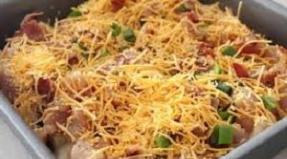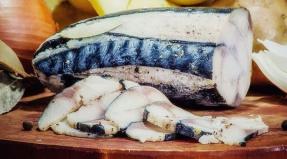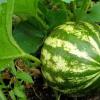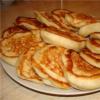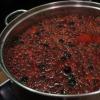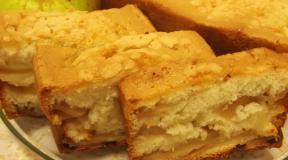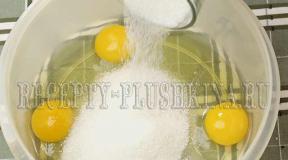We make cottage cheese from milk or kefir according to the best recipes. Frozen kefir curd
In our family, everyone is very fond of cottage cheese. It's a pleasure to do it. There are different ways of making cottage cheese at home, for example, cottage cheese can be made from kefir, from curdled when heated sour milk and even sour cream (store). For myself, I found perfect recipe fatty, tender cottage cheese which I want to tell you about.
Highly important point - delicious cottage cheese comes from homemade milk... It is always more interesting to buy homemade milk, firstly, you can collect cream from it. To do this, it must stand in the refrigerator for several hours. The cream will rise up and can be easily collected. I usually get about 700-800 grams of finished cottage cheese from 3 liters of homemade milk.
The next important point... We have already said that sour milk is needed for cottage cheese. Regarding the souring, I would like to say that it should sour when room temperature rather than in the refrigerator. Otherwise, the cottage cheese will be light unpleasant odor... Therefore, if the milk starts to turn sour and you intend to make cottage cheese from it, then it is better to take it out of the refrigerator and leave it at room temperature. How long will it sour? In winter, as a rule, about a day. In the summer, in the heat of just a couple of hours. Do not overdo milk! As soon as it sour, immediately take on the cottage cheese, otherwise it will oxyderate and the cottage cheese will turn out sour.
If you don’t want to wait for the milk to turn sour by itself, then “help” him. Add something sour to the milk: a piece of cottage cheese, sour cream, sour milk, or lemon juice.
Put the sour milk in a saucepan on water bath... We heat up to about 40 degrees. This temperature will be enough for the whey to come off. Done, and now the most delicious. To make the cottage cheese tender, fatty and tasty, we will do a few manipulations. Take sour cream and salt.

Add sour cream to the milk.

Do not stir in order not to disturb the structure of the curd.

Add a pinch of salt if you like salted curd.

And we pour everything onto a linen, gauze or waffle napkin.

We tie it with a bag and hang it for 40 minutes so that all the serum is glass.

After 40 minutes, you can untie and enjoy homemade fatty cottage cheese.

One more picture homemade cottage cheese... Bon Appetit!
Cottage cheese dishes are not only cheese cakes and casseroles. From this useful ingredient you can make a cake, cookies and even a snack for the festive table.
Lazy cottage cheese dumplings
Required products:
- three large spoons of flour;
- 200 grams of 5% cottage cheese;
- one egg;
- a pinch of salt;
- two tablespoons of sugar.
Cooking process:
- We knead the specified amount of cottage cheese with a fork, mix it with all the other components on the list, knead a homogeneous dough.
- We form a sausage (not too thick), cut it into small pieces, which we roll on both sides in flour.
- We send the blanks into boiling water, keep them on fire for about five minutes, after which we serve, for example, with sour cream. They can be frozen and used as needed.
Diet cheese pancakes without eggs
For those who want to lose weight, suitable dietary meals from cottage cheese. note that milk product better to take with minimum amount fat or no fat at all.

Required products:
- 0.25 kg of cottage cheese;
- a large spoonful of flour;
- one spoonful of sugar, or to taste.
Cooking process:
- Combine the indicated amount of cottage cheese with sugar and grind with a fork until smooth.
- When the mass is soft enough, add flour, mix again and form balls from this dough. Press them down a bit between your fingers to make a flat cake.
- We send blanks to hot skillet(preferably non-stick, so as not to use oil) and fry on both sides until golden brown.
Alternatively, you can put the semi-finished products in the oven for 25 minutes, setting the heating to 180 degrees.
Curd cake in the oven

Required products:
- h. l. baking powder;
- 0.25 kg of cottage cheese;
- two eggs;
- 120 grams of butter;
- one glass of sugar;
- half a glass of sour cream;
- one and a half glasses of flour.
Cooking process:
- Combine flour with baking powder and half of the specified amount of sugar. Then add the butter, cut into pieces beforehand (it should be chilled). Rub this mass with our hands so that a sticky crumb forms.
- Mash cottage cheese well with a fork or grind through a sieve, mix with yolks and sour cream.
- Combine the remaining sugar with proteins and beat with a mixer until foam forms. The result should be a mass that is about three times the original.
- Add the resulting mixture to the curd and bring until smooth.
- First we put half of the dough into the mold, and then the cottage cheese with proteins, which we also cover with the remaining dough.
- We remove the future dessert in the oven for 30 minutes, warming it up to 180 degrees in advance.
To make the process more understandable, we have prepared a step-by-step recipe with a photo. Feel free to add to your culinary piggy bank any of the options offered, and pamper home natural cottage cheese how in pure form and with various additives... It is prepared from milk, kefir, yogurt and other dairy products.
Heat treatment will take place at not too high temperatures. As a rule, the technology uses a water bath. For this, a saucepan with raw materials is placed in a bowl of water. At high temperature processing and increasing the duration of the process, the curd deteriorates its quality. It becomes tough and dry.
For cooking you need utensils:
- Glass jar;
- 2 pots of different diameters;
- Colander or strainer.
Also prepare the flap. natural fabric or folded gauze in several layers.
Before straining the cloth (gauze), wet boiled water and squeeze, and then nothing will stick to it.
To prepare homemade cottage cheese, they take milk from a cow or store milk. In the first case, the yield is greater, the product turns out to be fatter, and from store-bought pasteurized milk - softer and more tender.
When buying raw materials in the store, choose milk with a short shelf life and a fat content of at least 3.6%.
Whey is a byproduct of homemade cottage cheese. She herself possesses nutritional value, and it also behaves very well as a test base. So do not pour it out, but use it to make pies and okroshka.
How to make cottage cheese at home from homemade and store milk: a step-by-step recipe

Cottage cheese is a fermented milk product, it is obtained from sour milk, therefore the first stage of preparation is fermentation. For this reason, milk long-term storage will not work, it simply will not turn sour. We take it in polyethylene (by the way, it is cheaper). Be sure to look at the date of manufacture - only fresh milk is suitable for us.
On a note
Farm milk can be skimmed, but if you want to boil fat cottage cheese, this is not necessary.

Step by step cooking:

We talked about how to properly cook delicious coarse-grained cottage cheese at home from whole sour milk, gave a step-by-step recipe, but you can do without a water bath. A saucepan with curdled milk is simply put on low heat and warmed up. Be sure to watch out so that it does not burn. After curdling, proceed as described above.
Kefir: fresh and frozen

You can quickly make cottage cheese from kefir. The yield will be less than from yogurt, but the taste is no worse. We skip the fermentation stage and immediately put the dishes with kefir in a water bath. Remember to stir. The leftover whey can also be used, for example, to make pancakes or crumpets on it.
The heating temperature of kefir should not exceed 60 ° C, otherwise the cottage cheese will turn out to be tough.
For making homemade yogurt cottage cheese in a water bath, it is great glass jar, just do not forget to put a towel on the bottom of the pan so that it does not burst when heated. The process will be similar to the sterilization of preservation, with the difference that you do not need to bring it to a boil. The can is convenient in that it is not necessary to interfere with the mass, and readiness can be easily tracked by the separation of whey from the curd mass. This is very clearly visible through the glass.
A completely different technology is used for frozen kefir curd. In this case heat treatment not carried out.
Cooking steps:
- Put a pack of kefir in the freezer.
- After it freezes, take it out of the freezer, remove the packaging.
- Place the frozen kefir in a colander lined with a damp cloth or cheesecloth folded in 2-3 layers. Place a colander over a bowl or saucepan.
- Leave to defrost at room temperature for at least 5 hours. The time depends on the air temperature.
- When all the ice is thawed, drain the mass remaining on the gauze, transfer it to a glass or plastic container.
Cottage cheese from pre-frozen kefir turns out to be dietary, tender and soft, without grains. It resembles a cream in consistency. The taste depends on the quality of the original product.
If the room is cool, the defrosting process can take up to 10 hours. It is convenient to put the bag in the freezer in the evening and put the kefir ice on cheesecloth in the morning. Then fresh homemade cottage cheese will be ready for dinner.
In a slow cooker: with sour cream and sourdough

In a slow cooker, cottage cheese is prepared from kefir, fermented baked milk or sour cow or goat milk... If there is fresh milk and sour cream, then with the help of a miracle saucepan you can also make tasty product, only it will take more time, the process will take about 12 hours, and possibly even longer.
We will need such products;
- Milk - 10 glasses;
- Sour cream - ½ cup.
Preparation:
- Pour milk into the multicooker bowl.
- Add sour cream, stir. To make this easier, dilute the sour cream in a little milk, and then pour the liquid mixture into a bowl.
- Set the "Heating" mode, leave for half an hour.
- After 2 hours, turn on the heating again, but for 15 minutes.
- It is more convenient to put the cottage cheese at night, then the yogurt will be ready in the morning.
- For curdling at the final stage, turn on the multicooker in the "Heating" mode for 1 hour.
- Now it remains to throw the thick mass onto cheesecloth. Pre-fold it several times and put it in a colander, and place it over the pan.
- Wait for all the serum to drain.
- Do not try to speed up the process by stirring the mixture with a spoon. Leave it alone, as a last resort - tighten the edges of the gauze alternately from all sides.
- Shift as usual ready-made curd v suitable dishes and refrigerate.
Instead of sour cream, you can use any fermented milk product: kefir, fermented baked milk, yogurt.

You can prepare a tasty and healthy fermented milk product with special ferments in 8 hours. An excellent result is obtained with the BakZdrav sourdough. The instruction is attached to it very detailed. In a multicooker, this is done like this:
- Pour the leaven into the cooled boiled milk, stir.
- Pour the mixture into the multicooker bowl, turn on the "Yogurt" mode. If not, then set the temperature to 35-40 ° C, leave for 8 hours.
- Using a spatula, cut a dense layer right in the bowl into rectangles with a side of 2 cm (do not stir, just pick it up), set the temperature to 60 ° C, cook for 15 minutes.
- Strain through cheesecloth, cool.
Refrigerate for at least 2 hours, then serve. Children like this curd very much. It is stored in the refrigerator for no more than 3 days. If you add berries, fruits or raisins to it and pour over the syrup, you get a wonderful dessert.
Homemade cottage cheese with calcium chloride

If you need to increase the calcium content, then a pharmacy drug calcium chloride 10% is used for this. It is sold in ampoules and bottles. Observe precautions when using the ampoule.
To prevent glass from accidentally getting into the product, draw up the drug with a syringe with a needle.
- Milk - 300 ml;
- Calcium chloride - 1 tsp
How to cook:
- Boil milk
- Add calcium chloride, after which the milk will begin to curdle.
- Throw on cheesecloth, drain.
This technology achieves two goals. Firstly, the preparation is very fast, no preparatory measures are required. Secondly, cottage cheese is enriched with calcium, which is necessary for the normal functioning of the body.
Calcified cottage cheese is often prescribed for children; it is useful for the elderly as a prevention of osteoporosis.
We have given several options for how to cook cottage cheese at home. This can be done quickly with calcium chloride or without heat treatment by freezing and then thawing kefir. Delicious and delicate curd turns out in a slow cooker. And there is also classic way which our grandmothers used. In each case, the consistency will be different, and the taste will also be different, so you need to try and choose what your family will like.
Homemade cottage cheese is the tastiest because it is always fresh and natural. You can cook it different ways... Depends on the quality of milk final result... Someone likes fatty cottage cheese with an oily structure, but someone likes dietary product, with a little fat and sour taste.
How to cook cottage cheese at home for every taste - in detail in the recipes.
Step-by-step recipes for homemade cottage cheese from milk - basic technological principles
Cottage cheese is obtained from natural (whole) milk. As you know, milk contains a natural milk protein - casein. At a temperature of 10-12 ° C, milk matures within 12-15 hours. During this time, the structure of the protein changes, the process of natural fermentation begins.
Then the milk is heated. The whey is separated and a clot is formed: under the influence of temperature, casein fibers coagulate (contract), pushing liquid (whey) out of the cells. In a production environment, this process is called pasteurization. It occurs at 63-65 ° C for 20 minutes. As the temperature rises, the pasteurization time is shortened.
In fact, milk curdling occurs at a lower temperature - 40-45 ° C, but at dairy factories, where huge volumes of milk raw materials collected from different farms are processed, an increase in pasteurization temperature is due to sanitary standards. When there is absolute confidence in the observance of sanitary standards during milking, in the sterility of the dishes and the satisfactory maintenance of the animal, homemade milk can simply be warmed up before the serum begins to separate, and then removed from the stove and let it stand until completely cooled.
There is a pattern: the higher the milk pasteurization temperature, the worse the quality cheese grain... That's why the sour boiled milk never forms a normal curd, although, again, in production conditions, milk processed by high-temperature pasteurization is obtained soft cheeses... But there are special technologies for this.
There are some trade secrets you can use to make homemade cottage cheese. Some details industrial technology for making homemade cottage cheese from milk - in step-by-step recipes and useful tips.
Step-by-step recipe for homemade cottage cheese made from fresh milk
Ingredients:
Homemade milk 3.5 l (1 bottle)
Starter culture - the amount depends on the type of fermented milk product or enzyme
Calcium chloride 5% 5 mg (1 ampoule)
Cooking procedure:
1. The first stage is milk normalization. Of course, it is difficult to obtain milk of the required fat content by home methods, but the process can be approximately adjusted. The main thing is that the milk is whole. Fat content affects taste and texture. The industry produces low-fat cottage cheese, with a fat content of 9% and 18%. Choose your option and skim as needed.
2. Pour the milk into a saucepan and heat to 35-40 ° C.
3. Enter in warm milk leaven and stir for 5-7 minutes. Leave the pot at room temperature. Add calcium chloride at the same time to speed up milk clotting.
Usually sour milk without adding sourdough occurs within 7-8 hours. During this time, acidity increases, the product is enriched with lactobacilli, acquires a characteristic taste. This is an acidic way of making homemade cottage cheese. It is more natural.
Adding sour cream and other fermented milk products speeds up the process 2 times. Sour cream, yogurt, whey or yogurt are the most optimal way fermenting milk at home - these products can be found in every home. Only one required condition: dairy products must be prepared thermostatically, from whole milk.
If desired, replace fermented milk products with pepsin or other enzymes. This is the second, acid-rennet method of making homemade cottage cheese from milk, which can be used by replacing sour cream with an enzyme in the second step of the step-by-step recipe.
4. When a curd appears, place the pan on the stove and heat the raw material again, stirring, at a temperature of no more than 40-42 ° C. With strong heating, the quality of the curd will deteriorate. At the same time, fat and calcium will pass into whey, and the curd will noticeably decrease in volume and become dry. However, this option is also acceptable, but it is not for everybody.
5. Break the formed dense clot into small fractions to speed up the separation of the liquid.
6. Place a strainer or colander on a drip tray with a minimum capacity of 3.5 liters so that the whey does not overflow over the edge of the dish. Cover the sieve with four layers of cheesecloth and slowly pour in the fermented milk.
7. When the bulk of the whey has drained, tie the ends of a gauze napkin and hang it over the pan for a while to tighten the cheese curd and remove excess moisture from the product.
From the specified amount of homemade milk, you can get 350 - 400 g fresh cottage cheese.
Step-by-step recipe for homemade sour milk cottage cheese
Ingredient:
It so happens that the milk has already turned sour, and it must be "put into action". If the product has not been boiled, then it is quite suitable for making homemade cottage cheese. No special additives are required for such milk.
Preparation:
1. Sour milk must be heated. When the temperature rises to 40 ° C, the milk protein is curtailed. All this has already been described above, in the main technological principles obtaining homemade cottage cheese from milk.
2. Next step- separation of serum. Also, as in the first step-by-step recipe, place a sieve on a saucepan of a suitable size, and pour the warmed sour milk through the gauze layer.
3. Allow the whey to drain to the required moisture level of the curd. You can leave the curd in this position, and hang it in gauze to speed up the process of separating the whey.
Step-by-step recipe for homemade milk cottage cheese (with lemon juice)
This is a step-by-step recipe for making paneer, Indian homemade cottage cheese from milk. To curdle casein, Indians use sour fruit juice - it turns out homemade rennet cheese, with delicate taste and dense consistency. This cheese is not salty like feta cheese or feta, so it looks more like cottage cheese.
Ingredients:
Milk 6 l
Lemon juice 100 ml
Cooking procedure:
1. Preheat homemade milk to 40-50 ° C.
2. Squeeze the juice out of fresh lemon.
3. Pour it in a thin stream at the edge of a saucepan on the stove, while stirring the milk in one direction.
4. Do not stop stirring until a thick lump forms.
5. Allow the mass to cool, and pour through a gauze layer placed in a colander. You can put the clot into cheesecloth using a slotted spoon.
6. Fold the edges of the gauze towards the center. Install on cheese mass a plate, and on it - a jar filled with water. The curd should be compressed.
7. Transfer the finished head into a tightly closing container. Refrigerate for 10-12 hours to ripen. Paneer is cut into slices when serving. It is very good for salads and desserts, as a filling for dumplings and pies.
During the milk heating phase, you can add spices and spices to get original appetizer... Fit hot peppers, garlic, ground coriander, cardamom, mint.
Step-by-step recipes for homemade cottage cheese from milk - useful tips and secrets
Not every housewife has a lactometer to determine the fat content of milk. There is a way out: you can approximately set the percentage of fat content by volume. For example: a bottle contains 3 liters of milk. Put it in the refrigerator overnight. By morning, fat will rise upward, as its molecules are lighter and larger than liquid. The fat mass has a slightly creamy shade and is different in color from white milk. It remains to measure the volume of fat mass and determine the percentage of milk and fat. If in a bottle with a volume of 3 liters, the third part is fatty "vershok", the milk has a fat content of about 10%. This is a good indicator of milk quality.
Homemade cow's milk has the highest fat content in the cold season, when animals are transferred to winter housing. In such milk, the fat content reaches 12%. If you need to cook low-fat cottage cheese, put the milk in the refrigerator for 7-8 hours, then remove the cream - the raw materials for the cottage cheese are ready.
To speed up the clotting of milk protein, add calcium chloride to the milk raw materials. This additive is also used in the dairy industry. It allows you to increase the volume of cheese grains, enriches dairy products with calcium, which, when pasteurized, turns into whey. Calcium chloride is a cheap drug sold over the counter at any pharmacy. For a liter of milk, 0.5 ml of a 5% solution is enough. This is literally 2-3 drops of solution. Chloride is an absolutely harmless drug, but it should not be abused. As the great healer said, a medicine differs from a poison only in its dosage.
Goat milk is a very valuable and dietary product. It contains less fat than cow's milk, but coagulability in goat milk is lower, due to the structural features of milk protein. High-quality homemade cottage cheese from goat milk can only be obtained using the acid-rennet fermentation method.
The dairy industry produces cottage cheese made from reconstituted (dry) milk, skim milk, but these methods for homemade cottage cheese are complex, require the use of special household appliances and appliances.
There are products whose taste is familiar to us from childhood. These include cottage cheese - the undisputed king of the dairy kingdom. So, it would seem, there is nothing easier than making cottage cheese at home. Anyone who at least somehow cares about their health and their loved ones can afford it. Moreover, home product much healthier and tastier than the purchased one. However, despite the seeming simplicity of the process, few people do it regularly.
How to make homemade cottage cheese
At home, the very preparation of this fermented milk product takes several days. This is the simplest classic recipe assumes the presence of only good fatty cow's homemade milk - and nothing else is needed! Milk bought from the supermarket is not suitable as it is pasteurized. From three liters good milk it turns out less than a kilogram of cottage cheese. Notice from store product often whey is not completely drained, which leads to an increase in mass and a shorter shelf life. We can produce a fairly dry and crumbly cottage cheese!
Cooking technology
We just leave a jar of milk covered with gauze in the kitchen for souring. The process will start on its own, no need to add anything to the milk! If the apartment is not warm enough, you need to put the jar near the stove or battery. When thick white lumps are formed, the sour raw materials are ready for further transformations (the longer it costs, the more sour if you like it). First, leave the raw materials to sour for two days. Over time, you will already know when to stop the sourdough process, adjusting the time so that you get the most delicious curd.
Then slowly pour the raw material into a saucepan (trying not to shake it) and put it on the smallest fire. We heat until the serum separates. You can't boil! Keep on fire for a long time - too! If we bring it to a boil, then our cottage cheese will look more like rubber than a delicate and tasty product. Moreover, when boiling, all useful microflora perishes.
After we remove the future cottage cheese from the stove, let it cool for a while. We prepare a colander for further actions. We take the gauze, fold it several times and put it in the center of the colander. Pass the already cooled mass through this filter. Place a bowl under the colander to use the drained serum. When the liquid is completely drained, the edges of the gauze should be tied, and the structure should be hung over the bowl until the liquid stops dripping. Wringing out manually is prohibited! Everything should happen naturally. We extract the mass. The curd is ready! This is the most common answer to the question of how to make cottage cheese at home.

Kefir or yogurt
You can try to make cottage cheese from kefir, yogurt at home. The cooking process is the same as in the first recipe, but instead of milk we use either one or the other. The fat content of the resulting curd will depend on the fat content of kefir, and the yogurt, of course, must be natural, "live", without dyes and fruit additives... It is better to put fresh fruit pieces into our cottage cheese ourselves.
For baby
The baby begins to give cottage cheese from five to six months - in a carefully mashed form, at the very beginning of feeding. The dose gradually rises to 30 grams, so there is no need to cook curd on a global scale. By the year daily rate is only 50 grams. Do not give such small children cottage cheese, which is sold in the markets, as it has a short implementation time, and the fat content is not entirely suitable. Better to cook cottage cheese at home.

Recipe 1. On a water bath
You need to take kefir (from the dairy kitchen), pour it into a saucepan and put it in a water bath (up to 70 degrees). Keep at this temperature until a dense clot forms. Next, drain the whey and rub it through a sieve (remember about small amounts - from 500 grams of kefir you should get about 50-70 grams of cottage cheese, just daily portion for the kid). You do not need to harvest for the future, it is better to make fresh tomorrow!
Recipe 2. Delicate curd
Add a little kefir to the milk and bring the mixture to a boil, but do not boil! Place on a sieve. The curd is ready. It turns out in a very gentle way. You can add a spoonful of fruit puree to taste.
Recipe 3. Freezing
You need to freeze a pack of kefir in soft packaging in freezer... Then we cut the polyethylene, put it in a sieve, defrost it, strain it out. The curd is ready!

Recipe 4. With pharmacy supplement
We boil the milk, pour 10% calcium chloride into the hot one (we buy it at the pharmacy) at the rate of: a tablespoon in a glass of milk. It immediately begins to curl. We defend that the glass is excess liquid. Wipe through a sieve. Can be diluted with boiled milk.
Dietary
If you are going to make low-fat cottage cheese at home, you must either immediately take low-fat milk as a basis, or remove the cream from the milk that is starting to sour during the preparation process. Thus, a low-fat dietary product is obtained for those who monitor weight or follow a diet.

From goat milk
It is a wonderful universal product for all ages. In regions where goat milk and fermented milk products from it are regularly consumed, people get sick less, they are not worried excess weight and insomnia. It's connected with unique properties this milk, which can be consumed by both allergy sufferers and people suffering from diseases of the stomach and heart. Goat curd at home is also quite simple to prepare. There are several popular recipes for those who decide to learn how to make cottage cheese at home.
Serum
You need to take six liters of goat's milk (the output will be one kilogram of mass). Put to ferment in a warm place. To speed up the process, add about a glass of acid whey. The souring process lasts a day in summer, and up to 3 days in winter. When the pieces of mass are separated, the raw material is ready. For the convenience of further actions, we pour it into two three-liter cans(you can do it right away). Then we heat the curdled milk in a water bath (up to 70 degrees) for about half an hour. As a result, the whey goes down, and the curd floats up. We take the cans out of the pans, let them cool. We filter the cooled raw materials through cheesecloth. You can drain the serum with a rubber tube, and only then filter. Tie the gauze with a knot and hang it overnight. In the morning goat curd ready.

In a multicooker
How to make cottage cheese at home if you already have a slow cooker, so fashionable lately? Buy three liters of goat's milk, add a glass of kefir, stir and place in a warm place for fermentation (usually for a day). Sour milk should be thick, with large feathers. Pour the liquid into the multicooker bowl without stirring. We put on the "Heating" mode for three hours. Strain through a fine sieve. The curd is ready!
On a bread crust
An uncomplicated way, accessible even to a beginner in cooking. It is necessary to add a small crust there to improve the souring process of milk rye bread... At the end of the process, we extract it from the yogurt. Next, we follow the basic recipe.
As you can see, for those who decided to learn how to make cottage cheese at home, there are many recipes that allow you to make this delicious and healthy product.
Read also ...
- Recipes for making coffee with ice cream at home
- Strawberry panna cotta - a classic of world culinary What is panna cotta with strawberries
- Cream of curd cheese for cake - the best recipes for impregnating and decorating dessert
- Profiterole recipe and three original custard recipes Protein cream for profiteroles

